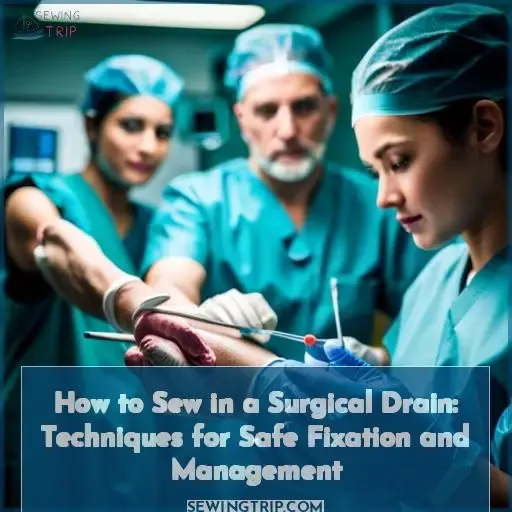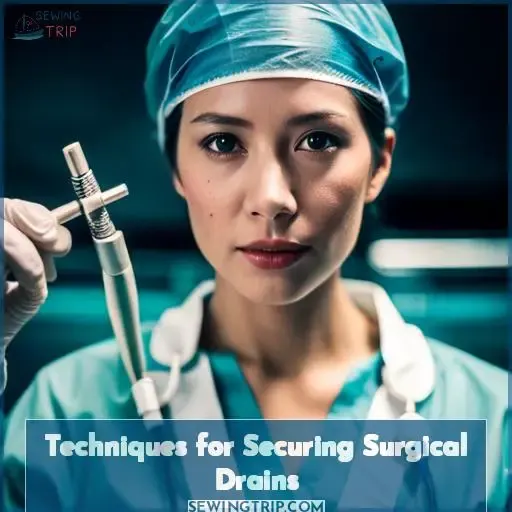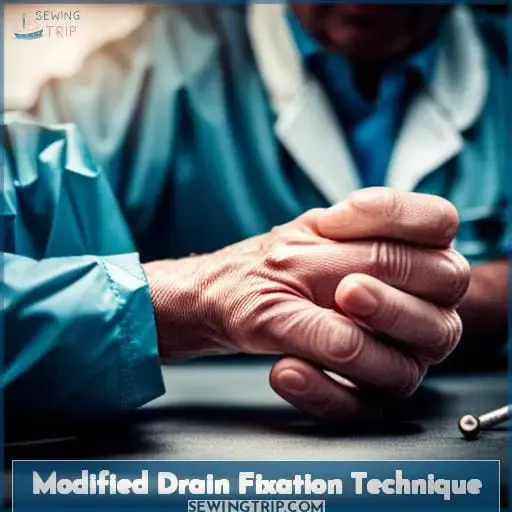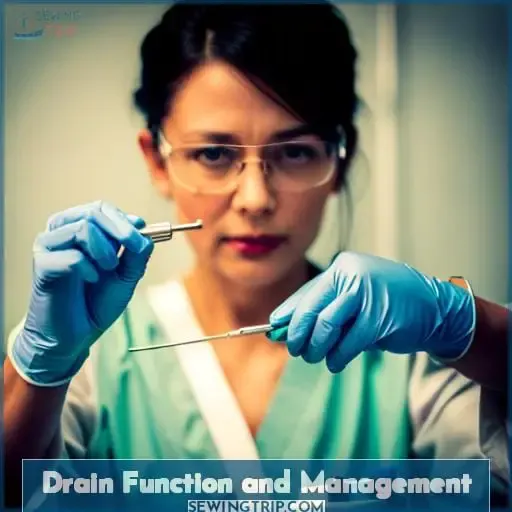This site is supported by our readers. We may earn a commission, at no cost to you, if you purchase through links.

Like this flower, your body is a marvel of resilience and healing. But sometimes, it needs a helping hand.
Enter the surgical drain, a lifeline that allows your body to drain away fluids and promote healing.
In this guide, we’ll delve into the art of sewing in a surgical drain, a technique that ensures safe fixation and management.
So you can return to blooming with vitality.
Table Of Contents
Key Takeaways
- Use skin-friendly tape instead of constricting suture knots to fixate drains, preventing skin damage and enhancing patient comfort.
- Carefully place drains during surgery and securely fixate them to prevent dislodgement.
- Monitor drain output frequently, send fluid samples for analysis, and report any concerning changes to the surgeon.
- Remove drains when output slows, generally 5-7 days after surgery, by cutting sutures and gently applying traction while leaving the exit wound open to heal.
Techniques for Securing Surgical Drains
When securing a surgical drain, you have three main techniques to consider:
- Tying a series of knots directly around the tubing.
- The Roman Gaiter fixation approach.
- The locking-turns method.
Knots Around Drain
You create a series of knots around the drain to secure it.
Pass the suture through the skin next to the drain exit site before looping it and tying a surgical knot.
Alternative skin-friendly methods like taping minimize discomfort while still allowing efficient drain management.
Roman Gaiter Fixation
Tying the suture to the skin while leaving both tails long and winding each end around the tube once before tying again allows you to secure the drain with the Roman Gaiter technique.
As you hold the tube upwards, wind the threads around the tubing, advancing along its length and placing a single throw each time the threads cross.
This alternative to traditional fixation techniques spares damage to the skin for easier drain removal and enhanced patient comfort postoperatively.
Locking-Turns Technique
After tying a suture to skin while leaving a tail, create multiple locking loops on the tube using the needled-end.
Draw the loops tight until the tubing is slightly waisted before tying the live end to the unused tail of the original skin knot to anchor.
This knotless solution provides secure fixation without constricting tissue.
The technique allows for tension adjustment to prevent damage while still keeping the drain in place.
Risks of Traditional Drain Fixation
With traditional techniques, overtightening knots around drains risks damaging tissue or leaving visible scars on patients.
Knots can constrict skin, leading to discomfort, infection concerns, and challenges with healing and knot removal.
Excessive tension places strain on the surrounding skin that impedes circulation and delays wound closure.
Tight fixation also heightens infection risk by introducing bacteria deep into tissue and inhibiting drainage flow from the wound.
Furthermore, the knots become embedded, making drain removal notoriously difficult and increasing the likelihood of visible scarring.
Consequently, classic drain fixation jeopardizes scar minimization, patient comfort, and seamless healing.
The risks outlined necessitate an alternative approach that prevents skin damage and safeguards the healing process.
Modified Drain Fixation Technique
However, traditional drain fixation risks skin damage.
An innovative, skin-friendly alternative uses tape to secure drains.
This scarless security approach fastens drains without constricting skin.
The technique involves:
- Cleaning skin around drain site
- Applying adhesive tape loosely around tubing
- Securing tape to allow slight drainage tube movement
Tape fixation prevents skin indentation, enhancing patient comfort.
The comfortable fastening reduces injury risk, infection rates, and healing time versus classic knotting methods.
Patients favor this simplified, non-abrasive approach to secure drains during surgical recovery.
Benefits of Modified Technique
When securing surgical drains, you should use a modified technique without skin knots.
This method prevents constriction and skin damage while increasing patient comfort.
It also reduces the risk of infection and delayed wound healing.
Prevents Skin Damage
You prevent skin damage by eliminating constricting knots around the drain exit site.
Instead, secure drains with skin-friendly tape that prevents adverse reactions.
This adhesive alternative enhances patient comfort while still keeping tubes firmly fixed.
The tape technique avoids tissue constriction, improving outcomes over knots that risk skin injury, delayed healing, discomfort, and visible scarring from excessive tension at exit sites.
Enhances Patient Comfort
By preventing skin damage, you’re also increasing patient comfort.
The modified technique avoids knot constriction that can cause discomfort.
This innovative method facilitates a comfortable recovery by eliminating skin irritation from restrictive sutures.
Patients report improved well-being and postoperative comfort with the technique.
By considering the healing experience, you can increase recovery satisfaction.
This patient-centered approach promotes patient comfort.
Reduces Infection Risk
Eliminating skin constriction lowers your risk of infection from drain exit sites.
Allows proper wound healing
Prevents skin breakdown
Enhances patient comfort
By securing drains with gentle adhesive tape instead of constricting knots, you prevent skin damage that invites infection. This facilitates proper wound healing, keeps patients comfortable, and reduces scarring risk.
Drain Function and Management
Techniques for Safe Fixation and Management:
Proper drain function and management are critical after placement.
- Secure drains at the exit site.
- Monitor fluid quantity and quality daily.
- Remove drains when output decreases.
Both passive and active drains require:
- Proper fixation.
- Suction if indicated.
- Removal when cytology improves.
Placement
To ensure proper drainage and functionality, the surgical drain should be carefully placed within the desired anatomical location while securing it to prevent dislodgement or complications.
Position the drain using aseptic techniques, tunneling it from the wound through a small incision.
Secure the tubing exit site with adhesive tape or sutures, taking care not to constrict skin.
Evaluate wound healing and patient experience to confirm proper placement and fixation allowing for optimal drainage.
Management
You’ll need to continuously monitor fluid quantity and quality while suctioning active drains.
Record drainage amount and appearance.
Send fluid samples for cytological analysis.
Correlate with patient’s clinical status.
Consider skin-friendly alternatives like the adhesive tape method for comfortable fixation allowing infection prevention and scar-free removal.
Removal
Its elimination involves:
- Cutting the sutures securing it
- Applying gentle traction to remove it
- Leaving the exit wound open to heal via second intention
- Applying a soft padded bandage for 3-5 days
Tape offers a skin-friendly alternative to traditional knots for securing drains.
It prevents skin damage while promoting:
- Patient comfort
- Easy removal
- Scar prevention
Frequently Asked Questions (FAQs)
What types of suture material can be used for securing surgical drains?
Non-absorbable, braided sutures are preferred for securing surgical drains.
Use polyester, polypropylene, silk, or nylon sutures to knot around tubing.
Their braided structure grips the smooth surface better than monofilament options.
Follow evidence-based techniques to prevent skin damage.
How often should surgical drain output be monitored after placement?
Monitor drain output at least every 8 hours after placement.
Assess the nature and amount of drainage frequently to detect issues early.
Promptly report concerning changes to the surgeon.
Consistent monitoring ensures proper drain function.
What signs or symptoms indicate a surgical drain needs to be removed?
Remove the surgical drain when:
- Drainage decreases substantially
- Fluid appears clear
Persistent high output or cloudy drainage likely indicates:
- Continued leakage
- Infection
How long after surgery are surgical drains typically left in place?
Surgical drains are typically left in place until the amount of drainage decreases to an acceptable level, often 5-7 days after surgery.
Closely monitor the drainage.
Remove the drains when output is minimal to reduce risk of infection.
What special considerations are there for securing surgical drains on infants and children?
Carefully secure drains to avoid constricting the infant or child’s fragile skin.
Use soft, non-adhesive dressings and loose, adjustable ties.
Check ties frequently to maintain proper positioning without compromising circulation or causing discomfort.
Conclusion
As the blossoms of spring,
You’ll bloom anew with the surgical drain’s nurturing care.
Though challenging at times,
Trust in its gentle guidance –
This lifeline shepherds you through trying terrain
Into lands of healing.
With time and patience,
You’ll unfurl renewed;
Where wounds once festered,
Now flourishes radiant recovery.
Let apprehension scatter like petals in the wind;
The drain’s ephemeral presence gifts the grace of mending.
Soon you’ll stand tall, tended by skillful hands;
The drain but a memory, its purpose fulfilled.











